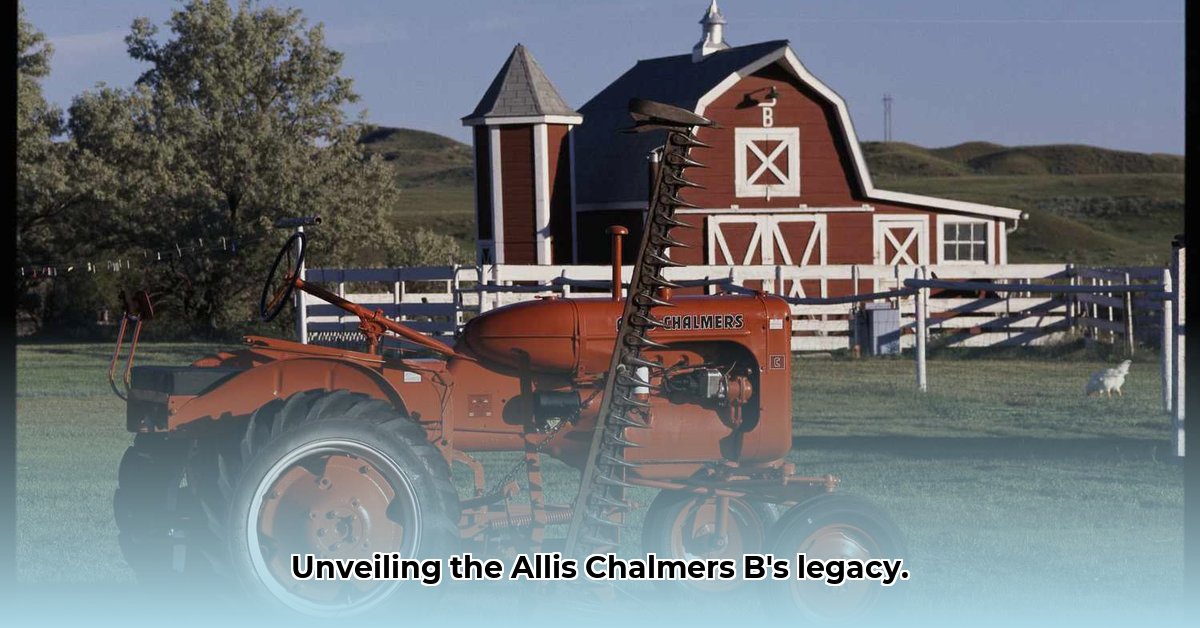
The Allis-Chalmers Model B tractor, a stalwart of the American agricultural landscape from 1938 to 1957, revolutionized farming for small landowners. This wasn't just another machine; it was a symbol of accessibility, affordability, and a significant step toward mechanization for those previously reliant on animal power. But how did this seemingly simple tractor achieve such a profound impact? Let's delve into its history, technology, and lasting legacy. For more on other classic tractors, see this useful resource.
The Allis-Chalmers Model B: A Small Tractor, Big Impact
Before the Model B's introduction, smaller farms faced significant challenges. Labor-intensive tasks like plowing were heavily reliant on horses, a process susceptible to weather conditions and animal limitations. The Allis-Chalmers Model B provided a practical and surprisingly affordable alternative, bringing the power of mechanization to a segment of the market largely overlooked by larger manufacturers. Its compact size and competitive price point made it an ideal solution for smaller operations, significantly shaping agricultural history.
Did you know that the Allis-Chalmers Model B's affordability was a key factor in its success? This accessibility fueled its widespread adoption, transforming the agricultural landscape and boosting the economic fortunes of countless small farms.
Engine Choices: Power to the People
The Allis-Chalmers Model B offered a degree of customization uncommon for its time. Farmers could select from several engines, each offering a different balance of power and performance to suit individual needs and budgets. The available options included the Waukesha, Allis-Chalmers BE, and Allis-Chalmers CE, exhibiting variations in displacement and horsepower. This catered to the diverse requirements of small farms, demonstrating Allis-Chalmers' forward-thinking market strategy.
| Engine Model | Displacement (liters) | Horsepower (approximate) |
|---|---|---|
| Waukesha | 1.9 | 14-18 |
| Allis-Chalmers BE | 1.9 | 14-18 |
| Allis-Chalmers CE | 2.1 | 18-22 |
The Technology: Simple, Yet Revolutionary
While lacking the advanced features of modern tractors – think manual steering, a non-synchronized transmission, and basic brakes – the Model B's design represented a remarkable leap forward for its time. The absence of power steering and hydraulics wasn't a deficiency; it was a pragmatic choice that kept the cost down while delivering substantial improvements over animal-powered farming. This simplicity was key to making the technology accessible to smaller farmers. The Model B reflects the ingenuity of its era: a robust solution tailored to specific needs, even with technological limitations.
The Economic Impact: A Rural Renaissance
The Model B's economic influence extended far beyond individual farms. Reduced labor costs and increased efficiency directly translated to higher profits for small farmers, proving crucial during economically challenging periods. This cost-effectiveness likely played a significant role in preventing farm closures and helped sustain rural communities. The full scope of its economic impact on rural areas remains a subject of ongoing research.
Manufacturing and Global Reach: A Tractor's Journey
The Allis-Chalmers Model B's production wasn't confined to the United States. Manufacturing also took place in Southampton, England, illustrating the tractor's broad appeal and Allis-Chalmers' far-reaching ambitions. This international reach further underscores the tractor's impact on global agriculture, though it also highlighted considerable logistical challenges.
A Lasting Legacy: Workhorse of the Ages
While technologically surpassed by contemporary designs, the Allis-Chalmers Model B's significance remains undeniable. It democratized farm mechanization, empowering smaller operations and shaping a more prosperous agricultural landscape. Its legacy serves as a testament to the transformative power of technological innovation and its positive impact on the lives of those who relied upon it. The Allis-Chalmers Model B: a true workhorse, and a symbol of ingenuity and resilience.
Comparing Allis-Chalmers Model B Engine Performance Variations: A Detailed Look
Understanding the performance variations within the Allis-Chalmers Model B tractor lineage requires a nuanced approach. While seemingly straightforward, the evolution of its engine and drivetrain significantly impacted efficiency and productivity for small-scale farmers. But how can one effectively compare these variations?
Key Factors in Performance Differences:
- Engine Displacement: Early models featured a smaller 1.9-liter engine, while later models saw a substantial increase in displacement (to 2.1 liters). This directly translated to a boost in horsepower.
- Transmission: The number of forward gears, initially three, increased to four in later models (C and CA models) enabling greater control of speed and power.
- Modifications: Post-purchase owner modifications often altered engine displacement and performance characteristics, making direct comparisons challenging. This highlights the importance of carefully documenting any modifications.
A Step-by-Step Approach to Comparison:
- Identify Engine Size: Establish the engine's displacement (cubic inches or liters).
- Assess Transmission Type: Note the number of forward gears (3 or 4).
- Document Modifications: Look for any alterations made to the engine or drivetrain.
- Utilize Nebraska Test Data (if available): This provides standardized performance benchmarks, although data may not be exhaustive for all modifications.
The advancements made to later models like the introduction of a hydraulic system, resulted in significant increases in overall productivity for the farmer.
The Impact of Engine Variations on Small Farms
These engine variations had a powerful impact on small farms. The increased horsepower and drivetrain improvements boosted efficiency, allowing farmers to cultivate more land in a shorter time. The accessibility of this increase in productivity, therefore, had a significant impact on improving the economic fortunes of smaller farms.